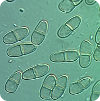Fusarium solani
Host(s)
Disease name
Depends on the host and part of the plant affected
Description
Fusarium solani is commonly referred to by its sexual name Nectria haematococca. There is an ongoing debate whether or not Fusarium solani and Nectria haematococca are the same species. As pathogens, members of this complex are responsible for disease on about 100 genera of plants. They represent one of the most important group of pathogens associated with opportunistic fungal infections and keratitis in humans, a condition in which the front part of the eye becomes inflamed. These fungi can survive in extreme environments. Fusarium solani is among the fungal species that were found in the highly radioactive inner parts of the damaged nuclear reactor at Chernobyl. Fusarium solani has been found growing in the caves at Lascaux in France where it is damaging the 15 000 year old paintings. The ability of these fungi to adapt to so many different environments shows their genetic plasticity and metabolic diversity. The most extensively studied species of the Fusarium solani complex is the "mating population" (MP) VI of Nectria haematococca which is also called Haematonectria haematococca. The term "mating population" defines a group of isolates that are sexually fertile with one another, indicating that they are a biological species. Nectria haematococca MPVI isolates can live in many habitats and analyses have demonstrated that the genes controlling the ability of individual isolates to colonise specific habitats are located on conditionally-dispensable supernumerary chromosomes ("CD chromosomes"). CD chromosomes are defined as supernumerary chromosomes that are not required for growth under all conditions but confer an adaptive advantage in certain habitats. Research has demonstrated that in Nectria haematococca MPVI, genes on these chromosomes are involved in resistance to plant antimicrobials, utilisation of specific carbon and nitrogen sources and in host-specific pathogenicity. The properties of these chromosomes suggest that some of these genes and perhaps even entire chromosomes might have been acquired through horizontal gene transfer and have properties similar to the genomic islands of bacteria.

